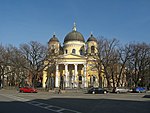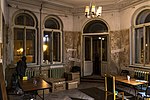Annenschule

Saint Anna German High School (Russian: Главное немецкое училище Святой Анны), usually known as Annenschule (Russian: Анненшуле), was a school in Saint Petersburg, Russia founded in 1736 for children of the German population of the city. In 1918, Annenschule became Soviet work school №11, and later school №203. Its alumni included well known people - ethnologist Nicholai Miklukho-Maklai, jeweler Peter Fabergé, philologist Faddei Zielinski, teacher and physician Peter Lesgaft, poet and Nobel Prize laureate Joseph Brodsky, actress Elena Granovsky, writer Igor Yefimov, and chess world championship pretendent Victor Korchnoi. In 1975 the famous city specialized high school №239 moved into the building.
Excerpt from the Wikipedia article Annenschule (License: CC BY-SA 3.0, Authors, Images).Annenschule
Фурштатская улица, Saint Petersburg
Geographical coordinates (GPS) Address Nearby Places Show on map
Geographical coordinates (GPS)
| Latitude | Longitude |
|---|---|
| N 59.945 ° | E 30.351 ° |
Address
Фурштатская улица 7
191123 Saint Petersburg (Литейный округ)
Saint Petersburg, Russia
Open on Google Maps









